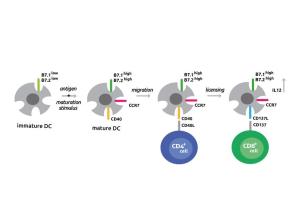In previous blogs, I invited you to read about the relevance of the B7-1 : CD28, B7-1 : CTLA4, the BLTA:HVEM, CD47:SIRPα , the GITR:GITRL, the CD40:CD40L and the PD-1/PD-L1/PD-L2 pathway for immunotherapy screenings and discussed the products available to work on these pathways. Today, I will focus on the CD137:CD137L pathway.
CD137 is another co-stimulatory protein that is expressed on activated T cells. Unlike CD40:CD40L signaling, which primarily involves helper T-cells, CD137 has a crucial role in the development of cytotoxic T-cells and anti-tumor immunity. Its ligand, CD137L, is mainly expressed on antigen-presenting cells, such as activated B cells, macrophages, and dendritic cells, as well as on human tumor cells.
Co-stimulation through CD137:CD137L enhances T-cell activation, promotes the rejection of cardiac allografts and skin transplants, and eradicates experimentally induced tumors in animal models. Several clinical studies are on-going that use agonistic anti-CD137 antibodies to induce an anti-cancer response to solid tumors.
All of these pathways can work in coordination. For example, CD137 is induced on normal and malignant B-cells by the CD40 signal, and studies involving combination anti-CD137 and anti-CD40 antibody therapy show greater survival rates in mouse cancer models. It is clear that these co-signaling pathways offer a promising intervention point for the treatment of many diseases. However there is still much to be worked out with the pathways discussed above, and there are even more immunosignalling targets being identified.
BPS Biosciences recently released a set of products linked to immunotherapeutically relevant targets, amongst them human CD137 and CD137 products.
Are you interested in this specific ligand or any other of the topics and reagents covered in previous blogs ? Don’t hesitate to get in touch via the form below!
References:
Wilcox, R.A., and Chen, L. 2007. TNF Superfamily, Landes Bioscience, p. 85-96.
Nakaima, Y., et al. 2013 PLOS One 8(5) :e64425.



